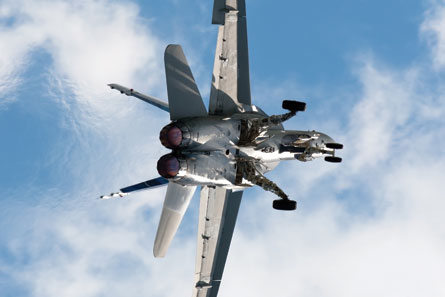With the Conservative Party election victory on 2 May, Prime Minister Stephen Harper's government is now free to finalise the long-term military modernisation strategy - dubbed Canada First - that was unveiled three years ago.
The document calls for yet more purchases of airlifters, helicopters and unmanned aircraft systems in the near term, with fighters and maritime patrol ships to follow.
At the same time, domestic budget pressures and Canada's imminent withdrawal from Afghanistan are likely to squeeze the capital investment budget of the Department of National Defense (DND).
Not least among these pressures are the disputed costs of Canada's commitment to buy 65 Lockheed Martin F-35s over five years, starting in 2016. Last July, the DND formally selected the F-35 for the next-generation fighter aircraft (NFA) contract in a decision that became a rallying cry for the Liberal opposition before the election.
In some ways, the Harper government's decision was predictable. The DND was among eight partner countries in 2002 that joined the F-35 international development programme, contributing about $150 million with an eye on procuring 80 fighters to replace Canada's CF-18s.
That decision invested the DND and Canadian industry in the F-35's development, but options during the procurement phase remained open.
As the DND established an NFA programme office in mid-2009, Boeing and Eurofighter started actively lobbying for an "open and transparent" competition. Both companies appeared at the annual Canadian defence and security symposium in June of that year in an attempt to make the public aware that alternatives were available.
Harper's government, however, ignored the pressure for a competitive bidding process. The DND trimmed its procurement budget from 80 to 65 fighters, but publicly announced its intention to buy the F-35 last July, at least four years in advance of a procurement contract.
Although opponents argued that DND had everything to gain financially by launching a competition, the DND had clearly made up its mind. All other candidates had already been disqualified from meeting the NFA requirement because the fighters lacked stealthy features only offered by the F-35.
Liberal Party leader Michael Ignatieff seized on Harper's commitment to the F-35 on a sole-source basis as one of a handful of key issues to ignite an opposition movement. For Ignatieff, the mistake was not focused on the selection of the F-35, but on the absence of a competitive bidding process for the most expensive weapons deal in Canadian history.
The results of the 2 May election will likely support the DND's current plans to buy 65 F-35As to fulfil the NFA requirement and replace the CF-18. Ignatieff's centre-left Liberal Party was not only defeated by the Conservatives, but lost its perch atop the opposition to the left-wing National Democratic Party.
Meanwhile, the Harper government is now added to the list of F-35 partners that have been forced to quell an internal insurrection about remaining committed to the Lockheed Martin stealth fighter. Both Norway and the Netherlands have defeated similar manoeuvring to remain committed to F-35 procurement.
However, the full costs of Canada's commitment to the F-35 may yet have to be fully counted.
Since the election, Harper has publicly re-assured Canadians that any F-35 cost increases have been anticipated in the government's long-term budget plans.
However, a report in March by the Parliamentary Budget Office (PBO) argues that costs to acquire and operate the 65-aircraft F-35 fleet are at least 66% higher than Harper's budget forecast of $17.6 billion, including $9 billion for procurement and basic maintenance over two decades.
The PBO report, however, predicts actual lifecycle costs of $29.3 billion over 20 years to buy 65 F-35s. These estimates are based on the US government's updated 2010 programme costs for the F-35, which have actually increased even further since the PBO report was completed.
The PBO report also reveals the budgetary impact a programme such as the F-35 can have on a country with the world's 13th-largest defence budget.
Indeed, if the PBO defence estimate is accurate, slightly more than five dozen fighters will account for roughly 7% of all defence expenditure forecast over the next 20 years by Harper's government.
This may be the price to maintain a modern fighter fleet, regardless of the aircraft model involved. Harper's representatives have argued that the Typhoon would actually cost more than the F-35.
The challenge will be keeping Canada's defence budget in balance with a wave of new requirements. Canada is nearing the end of a nine-year-long deployment to Afghanistan, The expedition drove Harper in 2008 to launch a massive modernisation programme, buying four Boeing C-17s, 17 Lockheed Martin C-130Js, six used Boeing CH-47Ds and 15 new CH-47Fs, leasing Israel Aerospace Industries' Heron 1 unmanned air systems.
Most pressingly, 17 new aircraft are required to replace 13 aging C-130s and six CC-115 Buffalos. A near-term requirement still exists for a medium-altitude long-endurance UAS, with the General Atomics Aeronautical System Inc MQ-9, the Heron and the recently unveiled Northrop Grumman Firebird potentially in the competitive field.
Beyond the near-term projects, the bill for the F-35 acquisition still looms as Canada also faces a need to start replacing its CP-140 Aurora fleet. However, it is not clear if the Canadian defence budget is large enough yet to pay all the bills. Beyond Afghanistan, budget priorities could shift to the navy, which desperately requires a new Joint Support Ship.
 |
|---|
©Air Team ImagesOn the way out: a Canadian Forces CF-18 |
Source: Flight International























